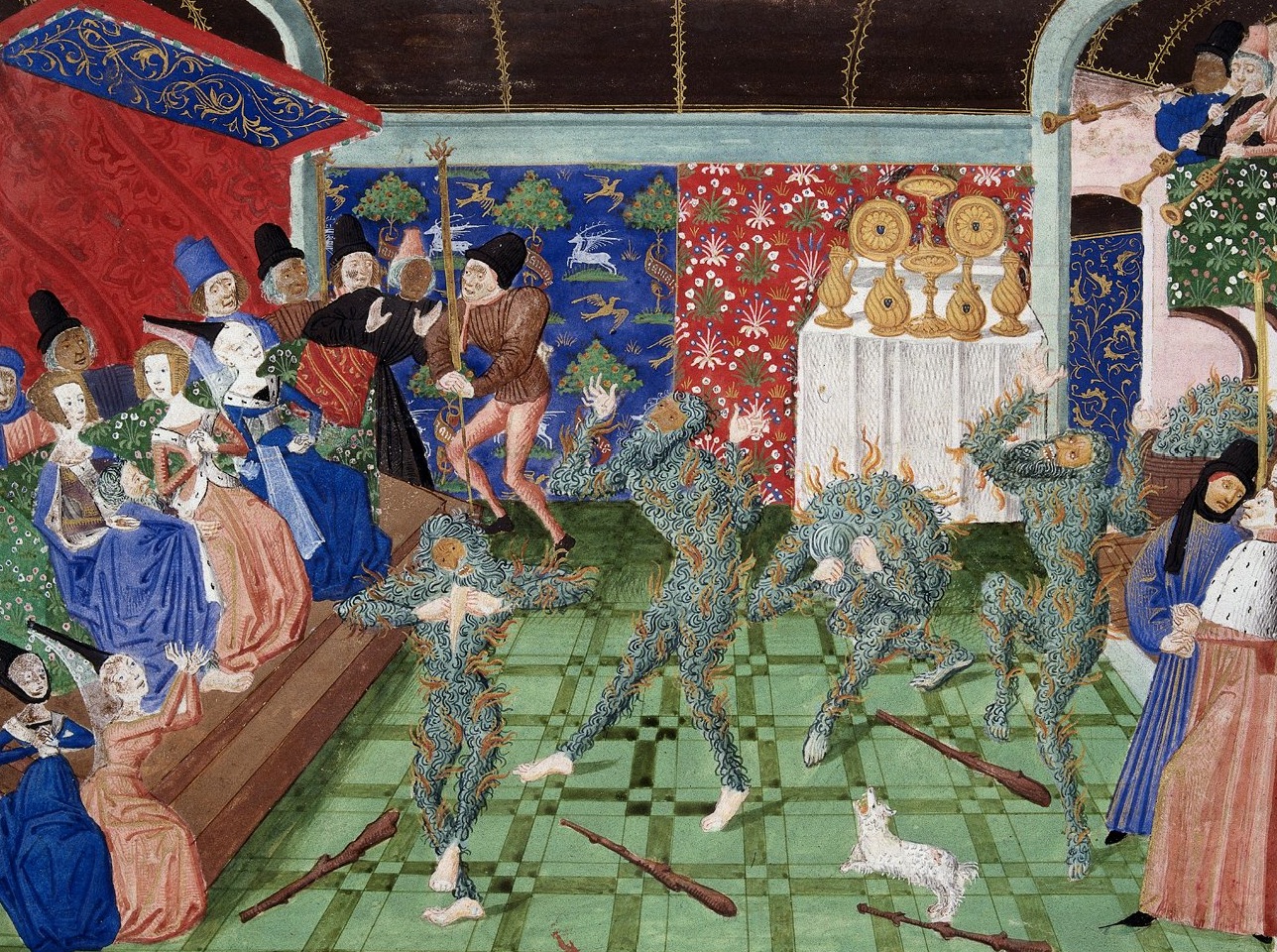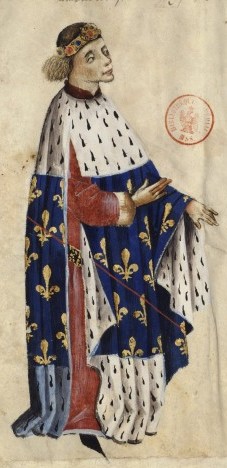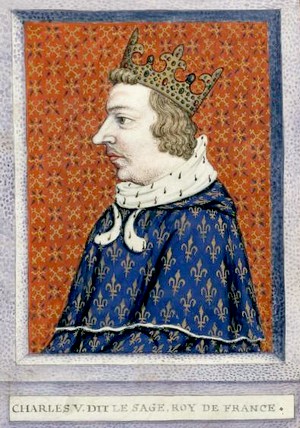|
Marie Of Valois, Prioress Of Poissy
Marie of Valois or of France (24 August 1393 – 19 August 1438) was a medieval nun and prioress, born a princess of France from the House of Valois as the daughter of King Charles VI of France. Life Early life Marie was born at the royal residence of the Château de Vincennes as the sixth child and fourth daughter of Charles VI of France (1368–1422) and his wife, Isabeau of Bavaria (c. 1370–1435). Only three of her five older siblings were still alive at the time of her birth: Isabella, aged 3, Joan, aged 2, and Charles, Dauphin of France, aged 1, but six more children were born to her parents after Marie, five of whom survived to adulthood. Marie's father seems to have suffered from a hereditary mental disorder. Isabeau decided to dedicate Marie to the service of God, possibly because she saw her husband's apparent madness as divine punishment. She was sent the at the age of 4 on 8 September 1397. The prioress there was her grandaunt, Marie of Bourbon (1347-1401), ... [...More Info...] [...Related Items...] OR: [Wikipedia] [Google] [Baidu] |
Charles VI Of France
Charles VI (3 December 136821 October 1422), nicknamed the Beloved () and in the 19th century, the Mad ( or ''le Fou''), was King of France from 1380 until his death in 1422. He is known for his mental illness and psychosis, psychotic episodes that plagued him throughout his life. Charles ascended the throne at age 11, his father Charles V of France, Charles V leaving behind a favorable military situation, marked by the reconquest of most of the English possessions in France. Charles VI was placed under the regency of his uncles: Philip II, Duke of Burgundy; Louis I, Duke of Anjou; John, Duke of Berry; and Louis II, Duke of Bourbon. He decided in 1388, aged 20, to emancipate himself. In 1392, while leading a military expedition against the Duchy of Brittany, the king had his first attack of delirium, during which he attacked his own men in the forest of Le Mans. A few months later, following the ''Bal des Ardents'' (January 1393) where he narrowly escaped death from burning, Char ... [...More Info...] [...Related Items...] OR: [Wikipedia] [Google] [Baidu] |
Christine De Pizan
Christine de Pizan or Pisan (, ; born Cristina da Pizzano; September 1364 – ), was an Italian-born French court writer for King Charles VI of France and several French royal dukes, in both prose and poetry. Christine de Pizan served as a court writer in medieval France after the death of her husband. Christine's patrons included dukes Louis I of Orleans, Philip the Bold of Burgundy, and his son John the Fearless. Considered to be some of the earliest feminist writings, her work includes novels, poetry, and biography, and she also penned literary, historical, philosophical, political, and religious reviews and analyses. Her best known works are '' The Book of the City of Ladies'' and '' The Treasure of the City of Ladies'', both prose works written when she worked for John the Fearless of Burgundy. Her books of advice to princesses, princes, and knights remained in print until the 16th century. Life Early life and family (1364–1389) Christine de Pizan was born in 1364 i ... [...More Info...] [...Related Items...] OR: [Wikipedia] [Google] [Baidu] |
Isabella Of Valois (1313-1388)
Isabella of Valois (1313 – 26 July 1383) was duchess of Bourbon by marriage to Peter I, Duke of Bourbon. Following her husband's death at Poiters, she took the veil. Isabella died 26 July 1383, aged seventy. Life Isabella was the daughter of Charles of Valois by his third wife Mahaut of Châtillon. On 25 January 1336 she married Peter I, Duke of Bourbon, son of Louis I, Duke of Bourbon and Mary of Avesnes. Peter and Isabella had only one son, Louis and seven daughters. Her husband died at the Battle of Poitiers in 1356, and Isabella never remarried. After her husband's death Isabella's son Louis became the Duke of Bourbon. In the same year 1356, Isabella arranged for her daughter Joanna to marry Charles V of France; as he was at the time the Dauphin of France, Joanna duly became Dauphine. She had as her butler Jean Saulnier, knight, lord of Thoury-on-Abron, councilor and Grand Chamberlain of France and bailli of Saint-Pierre-le-Moûtier. Upon becoming a widow, Isabell ... [...More Info...] [...Related Items...] OR: [Wikipedia] [Google] [Baidu] |
Peter I, Duke Of Bourbon
Peter I of Bourbon (Pierre Ier, Duc de Bourbon in French; 1311 – 19 September 1356) was the second Duke of Bourbon, from 1342 to his death. Peter was son of Louis I of Bourbon, whom he also succeeded as Grand Chamberlain of France, and Mary of Avesnes. Peter is reported to have been somewhat mentally unstable, a trait of nervous breakdowns (presumably hereditary, if mental illness is hereditary) that showed clearly for example in his daughter Joan of Bourbon, the queen, and in her son, king Charles VI of France, as well as in Peter's only surviving son, Duke Louis II. Early career Peter took part in several of the early campaigns of the Hundred Years War which broke out in 1337. In the summer of 1339, he took part in Jean de Marigny, Bishop of Beauvais's failed attack on Bordeaux. In autumn 1341 he took part in the John, Duke of Normandy's campaign in Brittany. He was present at the coronation of Pope Clement VI at Avignon 19 May 1342. By the summer 1342, Peter toget ... [...More Info...] [...Related Items...] OR: [Wikipedia] [Google] [Baidu] |
Bonne Of Bohemia
Bonne of Luxemburg or Jutta of Luxemburg (20 May 131511 September 1349), was born Jutta (Judith), the second daughter of King John of Bohemia, and his first wife, Elisabeth of Bohemia. She was the first wife of King John II of France; however, as she died a year prior to his accession, she was never a French queen. Jutta was referred to in French historiography as Bonne de Luxembourg, since she was a member of the House of Luxembourg. Among her children were Charles V of France, Philip II, Duke of Burgundy, and Joan, Queen of Navarre. Biography In June or July 1315, Jutta was betrothed to the future King Casimir the Great of PolandKazimierz JasińskiPolityka małżeńska Władysława Łokietka In: Genealogia - rola związków rodzinnych i rodowych w życiu publicznym w Polsce średniowiecznej na tle porównawczym, p. 14. but he married Aldona of Lithuania in 1325 instead. In 1326, Jutta was next betrothed to Henry of Bar. This arrangement was broken, however, and she stayed ... [...More Info...] [...Related Items...] OR: [Wikipedia] [Google] [Baidu] |
John II Of France
John II (; 26 April 1319 – 8 April 1364), called John the Good (French: ''Jean le Bon''), was King of France from 1350 until his death in 1364. When he came to power, France faced several disasters: the Black Death, which killed between a third and a half of its population; popular revolts known as ''Jacqueries''; Free company, free companies (''Grandes Compagnies'') of routiers who plundered the country; and English aggression that resulted in catastrophic military losses, including the Battle of Poitiers of 1356, in which John was captured. While John was a prisoner in London, his son Charles V of France, Charles became regent and faced several rebellions, which he overcame. To liberate his father, he concluded the Treaty of Brétigny (1360), by which France lost many territories and paid an enormous ransom. In an exchange of hostages, which included his son Louis I, Duke of Anjou, John was released from captivity to raise funds for Ransom of John II of France, his ransom. U ... [...More Info...] [...Related Items...] OR: [Wikipedia] [Google] [Baidu] |
Taddea Visconti
Taddea Visconti, Duchess of Bavaria (1351 – 28 September 1381) was an Italian noblewoman of the Visconti family, the ruling house in Milan from 1277 to 1447. She was the first wife of Stephen III, Duke of Bavaria, and the mother of the French queen Isabeau of Bavaria. Early life Born in Milan in 1351, sometime after 27 June, Taddea was the eldest child of Bernabò Visconti, Lord of Milan, and Beatrice Regina della Scala (1331–18 June 1384). She had fourteen younger siblings, but she was her parents' favorite child. Her paternal grandparents were Stefano Visconti, Lord of Milan, and Valentina Doria, and her maternal grandparents were Mastino II della Scala and Taddea da Carrara. Taddea's father Bernabò, continually at war with the papacy (for which he was excommunicated), was a ruthless despot, who would, in 1385, be overthrown by his nephew and son-in-law Gian Galeazzo Visconti and later poisoned in the castle of Trezzo. Marriage Bavaria was the wealthiest and most powe ... [...More Info...] [...Related Items...] OR: [Wikipedia] [Google] [Baidu] |
Stephen III, Duke Of Bavaria
Stephen or Steven is an English first name. It is particularly significant to Christians, as it belonged to Saint Stephen ( ), an early disciple and deacon who, according to the Book of Acts, was stoned to death; he is widely regarded as the first martyr (or " protomartyr") of the Christian Church. The name, in both the forms Stephen and Steven, is often shortened to Steve or Stevie. In English, the female version of the name is Stephanie. Many surnames are derived from the first name, including Stephens, Stevens, Stephenson, and Stevenson, all of which mean "Stephen's (son)". In modern times the name has sometimes been given with intentionally non-standard spelling, such as Stevan or Stevon. A common variant of the name used in English is Stephan ( ); related names that have found some currency or significance in English include Stefan (pronounced or in English), Esteban (often pronounced ), and the Shakespearean Stephano ( ). Origins The name "Stephen" (and it ... [...More Info...] [...Related Items...] OR: [Wikipedia] [Google] [Baidu] |
Charles V Of France
Charles V (21 January 1338 – 16 September 1380), called the Wise (; ), was King of France from 1364 to his death in 1380. His reign marked an early high point for France during the Hundred Years' War as his armies recovered much of the territory held by the English and successfully reversed the military losses of his predecessors. Charles became regent of France when his father John II of France, John II was captured by the English at the Battle of Poitiers in 1356. To pay for the defense of the kingdom, Charles raised taxes. As a result, he faced hostility from the French nobility, nobility, led by Charles II of Navarre, Charles the Bad, List of Navarrese monarchs, King of Navarre; the opposition of the French bourgeoisie, which was channeled through the Estates General (France), Estates-General led by Étienne Marcel; and with a peasant revolt known as the Jacquerie. Charles overcame all of these rebellions, but in order to liberate his father, he had to conclude the Treaty ... [...More Info...] [...Related Items...] OR: [Wikipedia] [Google] [Baidu] |
Black Death
The Black Death was a bubonic plague pandemic that occurred in Europe from 1346 to 1353. It was one of the list of epidemics, most fatal pandemics in human history; as many as people perished, perhaps 50% of Europe's 14th century population. The disease is caused by the Bacteria, bacterium ''Yersinia pestis'' and spread by Flea, fleas and through the air. One of the most significant events in European history, the Black Death had far-reaching population, economic, and cultural impacts. It was the beginning of the second plague pandemic. The plague created religious, social and economic upheavals, with profound effects on the course of European history. The origin of the Black Death is disputed. Genetic analysis suggests ''Yersinia pestis'' bacteria evolved approximately 7,000 years ago, at the beginning of the Neolithic, with flea-mediated strains emerging around 3,800 years ago during the late Bronze Age. The immediate territorial origins of the Black Death and its outbreak ... [...More Info...] [...Related Items...] OR: [Wikipedia] [Google] [Baidu] |
Bubonic Plague
Bubonic plague is one of three types of Plague (disease), plague caused by the Bacteria, bacterium ''Yersinia pestis''. One to seven days after exposure to the bacteria, flu-like symptoms develop. These symptoms include fever, headaches, and vomiting, as well as Lymphadenopathy, swollen and painful lymph nodes occurring in the area closest to where the bacteria entered the skin. Acral necrosis, the dark discoloration of skin, is another symptom. Occasionally, swollen lymph nodes, known as "buboes", may break open. The three types of plague are the result of the route of infection: bubonic plague, septicemic plague, and pneumonic plague. Bubonic plague is mainly spread by infected fleas from small animals. It may also result from exposure to the body fluids from a dead plague-infected animal. Mammals such as rabbits, hares, and some cat species are susceptible to bubonic plague, and typically die upon contraction. In the bubonic form of plague, the bacteria enter through the ... [...More Info...] [...Related Items...] OR: [Wikipedia] [Google] [Baidu] |
Robert, Duke Of Bar
Robert I of Bar (8 November 1344 – 12 April 1411) was Marquis of Pont-à-Mousson and Count and then Duke of Bar. He succeeded his elder brother Edward II of Bar as count in 1352. His parents were Henry IV of Bar and Yolande of Flanders. When Robert was less than a year old, his father died and his elder brother, Edward II of Bar, became Count of Bar under their mother's regency. As neither Robert nor Edward had a strong constitution, Yolande obtained a papal dispensation from Clement VI to allow them to eat meat during periods of abstinence. When his brother Edward died, Robert was still only seven years old and political problems associated with his mother's continued position as regent had arisen. Yolande was on the point of remarrying to Philip of Navarre, count of Longueville, a member of the Navarre family which was attempting to claim the French crown from John the Good. Joan of Bar, Robert's grandaunt, made known to the king that she was ready to replace Yolande and ... [...More Info...] [...Related Items...] OR: [Wikipedia] [Google] [Baidu] |







